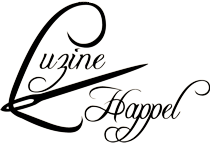Filling Patterns of Section 4 b II
The circle lends itself to a needlelace pattern. Since it is much easier to work needlelace over intact fabric, the fabric in the center of the circle is not cut away for now. First, markings are made – a circular line approx. 4mm from the outline. The inner circle is divided into eighths, with every other line following the grain and the others lying diagonally in between. All eight lines are marked at the same distance from the center.

Using coton à broder No. 16, Buttonhole stitches (not simple Blanket stitches) are first embroidered between the outline and the circular line.

Then threads are stretched three times over the straight lines and wrapped tightly on the way back without picking up the fabric. Even with further stitches, the fabric must not be accidentally picked up. The resulting center point is circled twice with needleweaving stitches.
At the level of the markings, the straight bars are connected in a circle in two rounds of laid threads. These connecting sequences form the basis for the needlelace pyramids. Start with five Blanket stitches. Work in back and forth rows, each time reducing by one Blanket stitch. The tip is attached to the Buttonhole stitches on the edge, the working thread is returned to the base along the edge of the needlelace pyramid. In the next section, the next needlelace pyramid is worked in the established way. Once all eight needlelace pyramids are finished, you can carefully cut away the fabric from the back of the work. The double knot of the Buttonhole stitch would hide the raw edge.
I decided to leave the fabric.

How to work the needlelace pyramids can also be found in my publication Schwalm Needlelace edge decorations – easily embroidered .
If you don’t have much practice with needlelace pyramids, it’s good to work with thick thread. Then you can tell the individual stitches better apart. Coton à broder No. 12 would also be possible – if available.
The tip above the circle is given a pattern without thread withdrawing: slanted, opposite Blanket stitches with a little space and with the loops along the center line (coton à broder No. 20.

The bellflowers also have a pattern without thread withdrawing. I chose closed herringbone stitch (also called closed feather stitch) (coton à broder No. 25). I also like to use this stitch to represent wide stems.

The first large heart should have an openwork pattern. The thread is withdrawn 2:2 and the thread grid is secured with Cable stitches (coton à broder No. 30).

I actually wanted to embroider a pattern with a diagonal structure (pattern 128 or 132 from Openwork Needleweaving Patterns). But then I decided on pattern 72 because the slant of the pattern fits better to the outline of the heart.

So section 4 b II has already received filling patterns.

Schwalm Band – Outline Design
Schwalm Band (1) Design Transfer
Schwalm Band (2) – Preparatory work of section 5
Schwalm Band (3) – Preparatory work of section 4
Schwalm Band (4) – Preparatory work of the sections 3 – 1
Schwalm Band (5) – Filling Patterns of Section 5 II
Schwalm Band (6) – Filling Patterns of Section 5 I







































